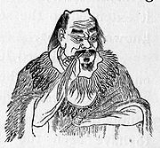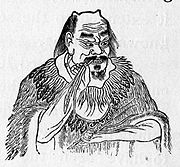
Yan Emperor
Encyclopedia

Han Chinese
Han Chinese are an ethnic group native to China and are the largest single ethnic group in the world.Han Chinese constitute about 92% of the population of the People's Republic of China , 98% of the population of the Republic of China , 78% of the population of Singapore, and about 20% of the...
ruler who lived in pre-dynastic China. Modern scholarship has identified the Sheep's Head Mountains just north of Gaoping
Gaoping
Gaoping is a county-level city in Shanxi Province, China with a history stretching back to the Warring States Period . Part of the city was formerly known as Changping where a noted battle took place in 260 BCE between forces from the rival States of Qin and Zhao.Gaoping is also famed as the...
in Shanxi Province as his homeland and territory.
A long debate has existed over whether or not the Yan Emperor was the same person as the legendary Shennong
Shennong
Shennong , which names mean "Divine Farmer", but also known as the Emperor of the Five Grains , was a legendary ruler of China and culture hero reputed to have lived some 5,000 years ago...
. An academic conference held in China in 2004 achieved general consensus that the Yan Emperor and Shennong were the same person. Another possibility is that the term Flame Emperor was a title, held by dynastic succession, with Shennong being known as Yandi, perhaps posthumously. Accordingly, the term Flame Emperors would be generally more correct. The succession of Flame Emperors, from Shennong, the first Yandi, until the time of the last Yan Emperor's defeat by Huangdi (the Yellow Emperor)
Yellow Emperor
The Yellow Emperor or Huangdi1 is a legendary Chinese sovereign and culture hero, included among the Three Sovereigns and Five Emperors. Tradition holds that he reigned from 2697–2597 or 2696–2598 BC...
, may have been some 500 years.
Historical Records
No written records are known to exist from the era of Yan's reign. However, he and Shennong are mentioned in many of the classic works of ancient China. Yan literally means "flame", and K. C. WuK. C. Wu
K. C. Wu was a Chinese political figure and historian.-Early life:K.C. Wu was born in Central China and grew up in Beijing, where his father served in the military. He studied at both Nankai High School, where Zhou Enlai was a classmate, and at Tsinghua University...
speculates that this appellation may be connected with the fire used to clear the fields in slash and burn
Slash and burn
Slash-and-burn is an agricultural technique which involves cutting and burning of forests or woodlands to create fields. It is subsistence agriculture that typically uses little technology or other tools. It is typically part of shifting cultivation agriculture, and of transhumance livestock...
agriculture. In any case, it appears that agricultural innovations by Shennong and his descendants contributed to some sort of social success that lead them to style themselves as di, "emperors," rather than hou, "princes," as in the case of lesser leaders. At this time it appears that there were only the bare beginnings of written language, and that for record keeping a system of knotting strings (perhaps similar to quipu
Quipu
Quipus or khipus were recording devices used in the Inca Empire and its predecessor societies in the Andean region. A quipu usually consisted of colored, spun, and plied thread or strings from llama or alpaca hair. It could also be made of cotton cords...
) was in use. The Zuo Zhuan
Zuo Zhuan
The Zuo Zhuan , sometimes translated as the Chronicle of Zuo or the Commentary of Zuo, is among the earliest Chinese works of narrative history and covers the period from 722 BCE to 468 BCE. It is one of the most important sources for understanding the history of the Spring and Autumn Period...
states that in 525 BC, the descendants of Yan were recognized as long having been masters of fire and having used fire in their names.
Downfall
The last Yandi, or Flame Emperor, met his demise in the third of a series of three battles, known as the Battle of BanquanBattle of Banquan
The Battle of Banquan is the first battle in Chinese history as recorded by Sima Qian's Records of the Grand Historian. It was fought by Huangdi, the Yellow Emperor, and Yandi, the Flame Emperor. The Battle of Banquan may actually only refer to the third of a series of three battles. Huangdi, the...
, probably on the Banquan plain, near the southern border of the modern Nei Mongol Autonomous Region
Inner Mongolia
Inner Mongolia is an autonomous region of the People's Republic of China, located in the northern region of the country. Inner Mongolia shares an international border with the countries of Mongolia and the Russian Federation...
, approximately 150 kilometers (about 93 miles) northwest of modern Beijing
Beijing
Beijing , also known as Peking , is the capital of the People's Republic of China and one of the most populous cities in the world, with a population of 19,612,368 as of 2010. The city is the country's political, cultural, and educational center, and home to the headquarters for most of China's...
. Yandi, or the Flame Emperor, was defeated by the rising Huangdi, or the Yellow Emperor
Yellow Emperor
The Yellow Emperor or Huangdi1 is a legendary Chinese sovereign and culture hero, included among the Three Sovereigns and Five Emperors. Tradition holds that he reigned from 2697–2597 or 2696–2598 BC...
.
Historicity
Since the Battle of BanquanBattle of Banquan
The Battle of Banquan is the first battle in Chinese history as recorded by Sima Qian's Records of the Grand Historian. It was fought by Huangdi, the Yellow Emperor, and Yandi, the Flame Emperor. The Battle of Banquan may actually only refer to the third of a series of three battles. Huangdi, the...
is treated historically by Sima Qian
Sima Qian
Sima Qian was a Prefect of the Grand Scribes of the Han Dynasty. He is regarded as the father of Chinese historiography for his highly praised work, Records of the Grand Historian , a "Jizhuanti"-style general history of China, covering more than two thousand years from the Yellow Emperor to...
, in his Historical Records
Records of the Grand Historian
The Records of the Grand Historian, also known in English by the Chinese name Shiji , written from 109 BC to 91 BC, was the Magnum opus of Sima Qian, in which he recounted Chinese history from the time of the Yellow Emperor until his own time...
, it would appear that this is a pivotal transition point between mythology and history. Ironically, Yandi enters history only with his demise. Apparently this demise was submission to the will of the Huangdi, than actual physical demise. In any case the title of Yan di appears to have lapsed, at this time, although his descendants seem to have perpetuated through intermarriage with Huangdi (see Descendants of Yan & Huang Emperors).
In popular culture
Both Huangdi and Yandi are considered in some sense ancestral to Chinese culture and people. Also, the tradition of associating a certain color with a particular dynasty may have begun with the Flame Emperors. According to the Five Elements, or Wu Xing model, red, fire, should be succeeded by yellow, earth—or Yangdi by Huangdi.List of Flame Emperors
This is the most common list given by Huangfu Mi, Xu Zheng, and Sima ZhenSima Zhen
Sima Zhen , courtesy name Zizheng , was a Chinese historian born in what is now Jiaozuo, Henan during the Tang Dynasty.Sima Zhen was one of the most important commentators on the Shiji...
:
| Name | Notes |
|---|---|
| Shennong Shennong Shennong , which names mean "Divine Farmer", but also known as the Emperor of the Five Grains , was a legendary ruler of China and culture hero reputed to have lived some 5,000 years ago... 神農 |
Born Jiang Shinian 姜石年 |
| Linkui 臨魁 | |
| Cheng 承 | |
| Ming 明 | |
| Zhi 直 | |
| Li 釐 or Ke 克 | Sima Zhen puts Ke between Ai and Yuwang |
| Ai 哀 | |
| Yuwang 榆罔 | Defeated by Yellow Emperor at Banquan |
List provided at the end of the Shan Hai Jing
Shan Hai Jing
Shan Hai Jing is a Chinese classic text, and a compilation of early geography and myth. Versions of the text have existed since the 4th century BC, and by the early Han Dynasty it had reached its final form. It is largely a fabled geographical and cultural account of pre-Qin China as well as a...
:
| Name | Notes |
|---|---|
| Yandi 炎帝 | |
| Yanju 炎居 | Also possibly known as Zhu 柱 |
| Jiebing 節並 | |
| Xiqi 戲器 | |
| Zhurong 祝融 | |
| Gonggong 共工 | |
| Shuqi 術器 | |
| Houtu 后土 | Brother of Shuqi |
| Yeming 噎鳴 | Son of Houtu |
| Suishi 歳十 |
See also
- ShennongShennongShennong , which names mean "Divine Farmer", but also known as the Emperor of the Five Grains , was a legendary ruler of China and culture hero reputed to have lived some 5,000 years ago...
- Yellow EmperorYellow EmperorThe Yellow Emperor or Huangdi1 is a legendary Chinese sovereign and culture hero, included among the Three Sovereigns and Five Emperors. Tradition holds that he reigned from 2697–2597 or 2696–2598 BC...
- Three Sovereigns and Five Emperors
- HuaxiaHuaxiaHuaxia is a name often used to represent China or Chinese civilization.-Etymology:According to the historical record, Zuo Zhuan, the ancient Xia Dynasty of central China was a state that held propriety and justice in high esteem...
- Zhonghua MinzuZhonghua minzuZhonghua minzu , usually translated as Chinese ethnic groups or Chinese nationality, refers to the modern notion of a Chinese nationality transcending ethnic divisions, with a central identity for China as a whole...
- Descendants of Yan & Huang Emperors

